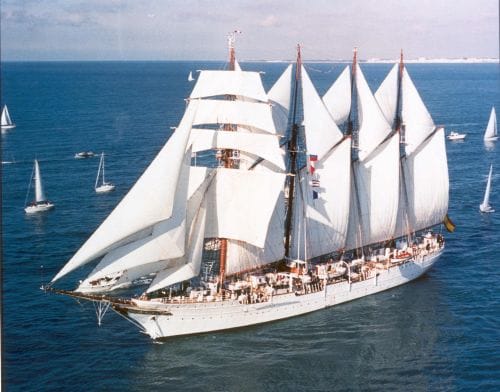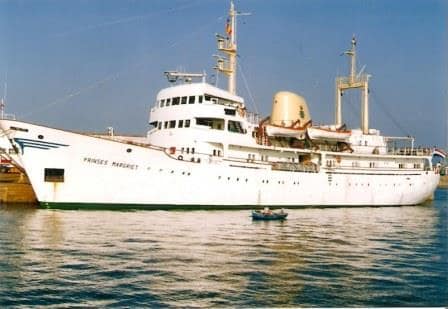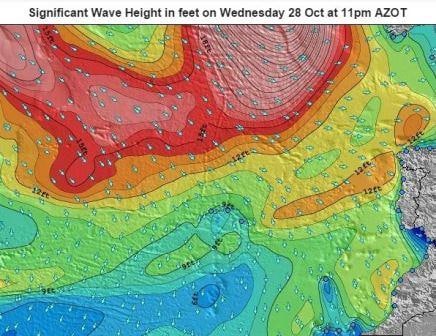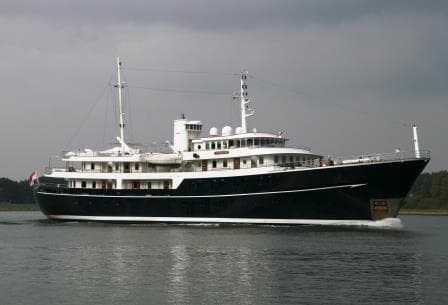Today we were in Cadiz Spain, which is just on the other side of the Straits of Gibraltar when looking west from Malaga. Cadiz is a very popular port to call at as it is located right on the edge of the North Atlantic Ocean. It is a regular port for ships which are coming from or commencing a crossing. The city is full of ruins and historical buildings and thus there are plenty of shore excursions available or self-exploring to do for independents. I had all but forgotten that Cadiz also has a Big Red Bus and by the time I saw one coming by the ship, it was too late to still hop on one. I must remember next time. I have done excursions here before and walked around the place but with regular buses your view is limited as the driver has the best view. But with an open top double decker, you can sit where the driver sits, just one deck higher and have a perfect view. Well I will be here again sometime in the future no doubt. But this time the Big Red Bus lost out on my contribution towards their yearly profit margin.
It was quiet in port today, hardly any movement of ships and only one cruise ship in port, the AidaCara of Aida cruises. This was the first ship Aida built and formed the base for their great success and current expansion.

I pulled this picture from a spanish website as my photo of the ship in port had too much background clutter. Muchias Gracias to the maker.
But another ship in port was of more interest as it was a square rigger or tall ship and those you do not see that often anymore. In this case it was the training ship Juan Sebastian de Elcano, of the Spanish Navy. There are several navys in the world who still have sailing training ships, especially the Latin American ones. Here we find the largest ones. The “de Elcano” is the 3rd largest tall ship in the world, the largest one is a cruise ship the Royal Clipper, followed by a Russian Training ship. It is an old ship, built in 1927 but through the years is has been renovated and updated several times so it can still sail as required.

The ms Prinses Margriet training ship of the Dutch Merchant Marine. She was a bit top heavy due to the class rooms and the 2nd bridge on the top and you noticed that in bad weather
There was a time when sailing ships were the preferred way of learning – literally – the ropes, of a seafaring job. It created comradeship and taught you to trust each other when hanging in the top of a mast with wind force 12. There were even shipping company’s such as the Hamburg America Line who had their own training ship. But these ships are expensive to maintain and operate and only some navy’s and dedicated training institutions still operate them. When I went to my Maritime Academy between 1976 and 1980 we still had a small motor ship on which we went 14 days a year and which was shared with the other Dutch Seafarer’s Institutes. Apart from finding out what seasickness was (that thing seemed to have been constructed especially to make bad weather even worse) and how too many crew could make a big mess, we did not learn much, but it was a nice vacation. I made two trips on this Prinses Margriet and both times we had nice weather, much to the chagrin of the Captain who seemed to specialize in finding even the smallest disturbance out there in the North Sea. The little ship is still afloat after a complete rebuilt and now operates as small cruise yacht called the Sherakhan. They lowered her superstructure considerably which must have greatly improved her behavior at sea.
That experience has always made me doubtful about the usefulness of training ships for the Merchant Marine and the Dutch Merchant Navy does not have one any more. A cadet training year on a commercial vessel and bridge simulator work is deemed to be much more beneficial than messing around with sails and getting cold and wet on the deck of a square rigger.
Tomorrow we start our crossing of the North Atlantic Ocean. Today the ship topped up all its tanks with fuel oil so we have more than sufficient to get to the other side. If all goes well we should arrive in Fort Lauderdale on the 9th. of November . It is not a direct crossing as we call at the ports of Punta Delgada and Horta in the Azores.
The weather is now getting harder to predict. For the Ponta Delgada port call we are looking at partly Cloudy with 16oC/61oF. That is the good part. Getting there might be different.

Red is never good on a weather chart. But for tomorrow the waves are still green and thus low. the Azores are in the centre of the chart (Courtesy www.surf-forecast.com)
For a crossing, the wind and rain are not so important, what is of interest is the swell as that makes the ship wobble. And that can reduce the happiness on board considerably. There is a depression out there, north of the Azores with the potential of coming over the Islands and/or pushing a large wave field that way. If that is going to happen, then we might get some lively movement on Friday, the day before we arrive at the islands. We will see.


October 28, 2015 at 4:44 pm
Dear Captain Albert, thanks for answering my question yesterday about the ‘small’ PPE.
Its always very interresting to read your blogs. It reminds me of my days in HAL and my carreer as a Rotterdam pilot. So was this one, especially what you wrote about the training vessel “Prinses Margriet”. Almost from her start in 1967 as a training vessel I was navigation and training officer on that beautiful rolling and pitching white lady during two and a half years. It was a great time and after a while I even got used to the unpleasant movements. Because in this government company ( KOFS ) we could not collect extra days to go to Nautical College for our next certificate, I studied on board. As soon as we arrived in Amsterdam I rushed to the College to collect lecture notes and several times I went to a coach for testing and rehearsing. Wow, those were the days! Thanks Captain for this wake-up call!
October 29, 2015 at 10:25 pm
Even as a bystander I couldn’t help but be in awe watching the rigorous training on board the “Danmark”. a Danish square rigger in the Tallinn harbour.
Of course, you know of this Danish navy training vessel as well, Captain. I happened to be in the harbour when the sailors were ordered to climb to the top of the most forward mast (term?) Needless to say that I made gazillions of pictures.